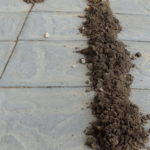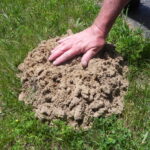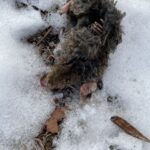by Winding Pathways | Apr 20, 2023 | (Sub)Urban Homesteading, Garden/Yard, Garden/Yard
People make a “to-do” about moles. They might be the most disliked animal in suburbia. We have them at Winding Pathways and are sharing tips on what we do about them.
Human Created Problems
Suburban and urban soil has a common problem. It is too often compacted. Construction companies often scrape topsoil off a yard before building a house. Then, they drive vehicles in the yard. When a family moves in, they soon create a dog run, drive their cars on the grass, and play on the lawn. Too many footsteps by pooches or people compact the ground.
Nature Has Solutions
Lawn plants struggle to thrive in tight soil, but nature has a remedy. Fossorial animals live in the soil and include moles, gophers, shrews, ants, worms, and others. Their burrowing constantly mixes and softens the dirt they live in, making it easier for plants to live.
Moles or Gophers?
People often confuse moles with gophers, but it’s easy to tell them apart. Moles prefer living in moist shady places and are at home in suburbia. They eat grubs and worms. Gophers, in contrast, are more likely to live in rural sunny pastures with dry soil and mostly eat roots. Mole hills are symmetrical, like mini volcano cones. Gophers, in contrast, make elliptical hills.
What Do You Really Value?
Ironically, most people who trap or poison moles profess to love a rich, green, “healthy” lawn, ignoring that nature loves diversity, not monocultures. Moles help make healthy lawns happen. Granted their hills of dirt and heaped linear tunnels can be unsightly and catch lawn mower blades.
Here is what we do at Winding Pathways:
- Thank our moles for helping make the soil soft and fertile.
- Rake out their hills before mowing.
- Stomp down their raised tunnels so our lawn mower does not catch on them.
- Enjoy the diversity of life in our yard.
Moles are as fascinating and beneficial as the butterflies that pollinate blooms or the cardinals who pluck seeds from feeders. They deserve respect for their valuable work.
-

-
Moles bring rich dirt from below to the surface as they tunnel along hunting for earthworms and grubs.
-

-
Moles sometimes push up excess dirt.
-

-
Moles’ feet are made for clearing dirt away.
by Winding Pathways | Jun 17, 2021 | (Sub)Urban Homesteading, Pests

Moles sometimes push up excess dirt.
It’s that season again. Recently we spotted a symmetric dirt cone poking up in our lawn. Fortunately, it wasn’t an early-stage volcano about to erupt. Rather, a mole pushed dirt out of the way so it could continue tunneling.
People hate moles for forming similar dirt piles and their humped tunnels that lawnmower blades sometimes catch. Here’s some basic mole information to help change perspective from a “problem” to a resource and “radical welcoming”.
A Mole Primer
Moles are small mammals of several species that live across North America, Asia, and Europe. They make their living tunneling through the earth to find earthworms and other invertebrates to eat. Contrary to popular belief moles don’t eat plants or roots. They make two types of tunnels. One is fairly deep and is a mole’s highway. It’s for transportation. The other is the familiar humped tunnel moles create to find food that usually is just below the soil surface. Every once in a while, a tunneling mole needs to get rid of some dirt, so they push it to the surface, creating a molehill.
Mole or Gopher?
People confuse moles with gophers. Both are small tunneling animals, but they are very different in these ways:
- Moles eat invertebrates, not plants. Gophers eat plants and roots.
- Moles are most common in moist shady soil and suburban yards. Gophers are more common in open sunny areas, like pastures, and rarely enter suburbia.
- Moles create symmetric hills of dirt. Gophers make elliptical-shaped mounds.
- Mole populations are usually small, while there may be many gophers living in an area.
By softening and aerating the soil both types of animals promote long-term soil health. Often an area bordering a mole tunnel will have the greenest grass in the lawn, for example.
Killing Moles
Mole dislike is so intense that many people work hard to kill any that dare tunnel in their yard. Here are two common mole weapons and why we don’t use them:
- Plunge-type traps impale a hapless mole. We worry that a neighborhood child or someone’s pet could be speared by one of these traps, which also are cruel.
- Poison peanuts are sold in garden stores. The package may say the peanuts will kill moles……and they will if you can get a mole to eat one, but remember that moles eat worms and insects, not peanuts or plants. A peanut is a plant. So people who buy poisoned peanuts are wasting their money and poisoning critters that may eat the poisoned peanut. Like a favorite, curious dog.
What We Do with Moles at Winding Pathways
We view our moles as another interesting and beneficial animal that shares our yard. Yup, mole tunnels kill a strip of grass in the short term, but in the long term, mole activity improves the soil. Worms and most other invertebrates contribute to soil health, so we know if we have moles, we have a healthy lawn.
What to Do About Moles
There are two ways to deal with moles. First, a homeowner can set traps and poison and attempt to kill beneficial animals. Second, forget trying to “get rid” of moles. Instead, just tamp down their tunnels before mowing, and don’t worry about them.
We follow the second.
by Winding Pathways | Feb 22, 2018 | (Sub)Urban Homesteading, Garden/Yard, Mammals
Moles in winter? You bet! We were amused and amazed to look out our den window and see a heaped-up line of topsoil on top of several stepping stones. Even in Winter, our moles are active!
Many people hate moles because their tunneling raises mini ridges in the lawn and their hills smother a patch of grass and get

Moles bring rich dirt from below to the surface as they tunnel along hunting for earthworms and grubs.
caught in a lawnmower’s blades. Some go to great lengths to poison or kill moles.
How Moles Are Helpful
We don’t. They’re amazing animals that provide us with a wonderful service. Their endless digging in search of earthworm and insect meals softens the soil, enabling water to easily percolate in and helping plants grow. The greenest grass of the lawn always seems to be where moles tunneled last year.
Instead of persecuting our moles we simply stomp down the raised tunnels and rake out the mole hill before mowing, and then we quietly thank our subterranean helpers before starting up the lawnmower.
Moles are active all year but the frozen ground is daunting for them. Our January moles were tunneling in the soft unfrozen soil on the south side of the house and under dark stones that catch the sun’s heat and keep the ground underneath them unfrozen. We hope they found some grubs and worms for dinner.
We’re happy to share our yard with moles and appreciate the positive impact they have on the soil. Watch this YouTube Video about moles.
by Winding Pathways | Sep 2, 2014 | (Sub)Urban Homesteading, Garden/Yard, Mammals, Nature
Few animals frustrate homeowners as much as moles, but at Winding Pathways we appreciate them. Moles are Mother Nature’s roto tillers, and like mechanical tillers they soften and mix soil, helping plants grow.
The common Eastern mole only weighs about four ounces. It stays underground and is rarely seen, but the evidence of this animal’s foraging is easy to spot. Humped ridges wee waw around a lawn and volcanic like cone-shaped hills of loose dirt appear as if by magic. See them and moles have been at work.
Ridges are created as moles swim through the soil seeking tasty earthworms and grubs for dinner. They are most active in the evening and morning and prefer loose soil, especially in shady areas.
People who want their lawn to be as perfect and blemish free as carpeting hate moles and endlessly and needlessly persecute them. We like them because visible mole tunnels and hills tell us that our lawn is rich in worms, grubs and other underground animals that are natural components of the soil. In short, our lawn is healthy and ready for children to play on safely.
An insect and worm free lawn is unnatural and likely happens when people poison the soil in an effort to discourage moles. It works. With no food available, moles move elsewhere, leaving the homeowner with a blemish free unnatural lawn that may be toxic.
During the heat and dryness of late summer lawn grasses want to go dormant. Moles move to shady cooler woodlands, abandoning lawns until fall rains resume. Ironically, the people who hate moles often water their lawn during summer droughts, creating perfect conditions to attract the tiny mammals.
Commercially sold poison peanuts are ineffective because moles don’t eat peanuts. They’re insectivores. Plunging spear traps pose safety hazards to small children. Moles often don’t reuse humped up feeding tunnels. They’ve already caught the food there. Traps and poison set over tunnels may kill harmless shrews and mice that use them as highways.
We’ve noticed that places where moles were most active last year have the greenest grass this year. That’s probably because last year’s diggers made the soil softer and added a bit of natural fertilizer in their droppings. Mother Nature’s roto tillers at work.
The best solution to a “mole problem” is simply to ignore it and allow the small animals to go about their business improving soil health. Simply stomp down tunnels and rake out hills before mowing. New grass grows quickly in this newly enriched top soil.



